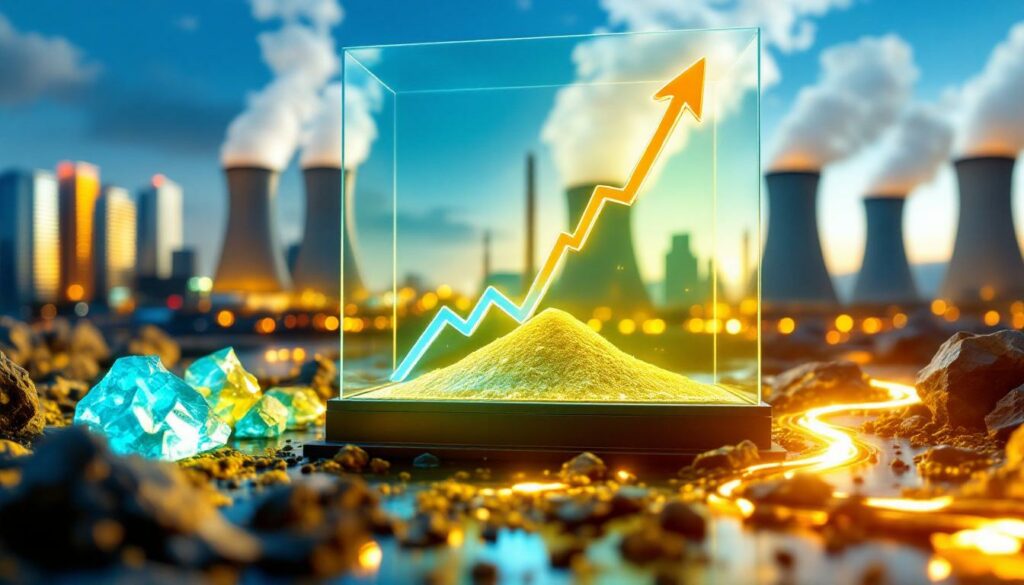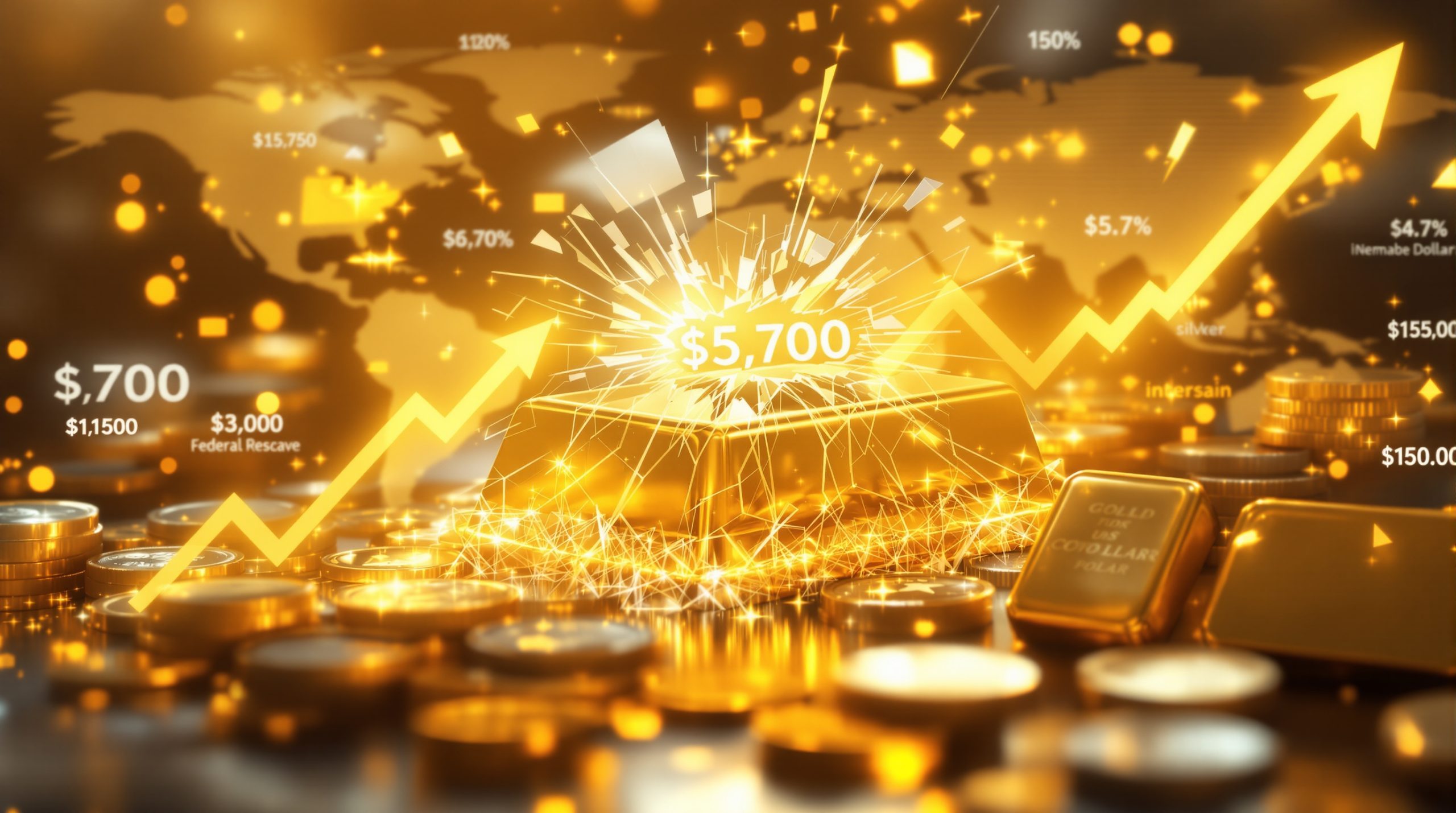How Has the Uranium Market Recently Changed?
The uranium market has experienced unprecedented volatility recently, with one of the most significant one-day price spikes in years occurring in June 2025. This dramatic shift was triggered by the Sprott Physical Uranium Trust (SPUT) announcing a substantial capital raise, initially set at $100 million but quickly upsized to $200 million due to strong demand. This unexpected move sent shockwaves through what is happening in the uranium market, with some companies experiencing remarkable single-day gains.
The Recent Price Surge Explained
The uranium spot price jump following SPUT's announcement represented the largest one-day increase in years. This price movement wasn't isolated to the physical commodity—uranium equities responded with even more dramatic gains:
- Deep Yellow: Surged approximately 20% in a single trading day
- Boss Energy: Gained roughly 16%
- Alligator Energy: Rose about 15%
- The Sprott Uranium Miners ETF (URNM): Increased by approximately 7%
"What we're witnessing is the classic high-beta relationship between uranium equities and spot prices—where a modest percentage change in uranium prices can trigger amplified movements in related stocks, often in the 3-5x range." — Money Miners Podcast
This price action demonstrates the unique dynamics of the uranium market, where financial flows can have an outsized impact on physical commodity prices and equity valuations. The thin nature of the uranium spot market, which saw only about 50 million pounds traded throughout all of 2024, means that even modest purchasing activity can significantly influence prices.
What Is the Sprott Physical Uranium Trust (SPUT)?
SPUT is a physical uranium trust that currently holds over 66 million pounds of uranium, representing approximately 15% of the global spot market. With assets under management of approximately $5 billion, the trust functions as a vehicle for investors to gain exposure to physical uranium without directly handling the commodity.
How SPUT Influences the Market
SPUT operates with a specific mechanism that significantly impacts the uranium market:
- It raises capital through share issuances
- Uses the proceeds to purchase physical uranium
- Can only add more uranium when trading above Net Asset Value (NAV)
- Incurs management fees of 0.35% annually
- Charges inventory carry costs of approximately $0.50/lb/year
The trust's recent $200 million capital raise represents purchasing power for approximately 2.5 million pounds of uranium. For context, a UxC model suggests that a 1 million pound SPUT purchase typically corresponds to roughly a 2% spot price increase.
SPUT's Recent Financing Activities
Prior to the June 2025 $200 million raise, SPUT had completed a smaller $25 million financing in May 2024. This earlier raise was done at a 9% premium to NAV, which was notable given that the trust had previously been trading at a persistent discount.
"The May 2024 financing was critical in alleviating market concerns about SPUT potentially selling uranium to fund its operations. It showed renewed investor confidence in the uranium thesis." — Sprott Asset Management Press Release
Since its inception in 2021, SPUT has accumulated over 100 million pounds of uranium, with its buying activity often correlating directly with significant spot price movements. The 2023 buying spree, which removed 1.5 million pounds from the spot market over just five months, drove prices from $60/lb to $90/lb according to UxC Consulting's Q4 2023 report.
Why Are Financial Players So Active in Uranium?
The uranium market presents unique characteristics that make it particularly susceptible to financial influence, especially compared to other commodity markets like gold or oil.
The Financial Dynamics Behind Recent Movements
Several factors make uranium vulnerable to financial positioning:
- Thin Trading Market: The uranium spot market features relatively few transactions, with trades often involving just 100,000 pounds at a time.
- High Short Interest: Many uranium equities had significant short positions before the recent price surge, with ASIC Short Position Reports showing Boss Energy at 18% and Paladin Energy at 15-16%.
- Potential Short Squeeze: The combination of SPUT's buying activity and high short interest created conditions for a short squeeze, similar to (though less extreme than) the GameStop phenomenon of 2021.
- Equity Beta Advantage: Uranium equities typically move with higher volatility than the underlying commodity, with the URNM ETF showing a 3-year beta of approximately 2.8 versus spot prices according to Bloomberg data.
The Strategic Timing of SPUT's Announcement
Market observers noted that uranium equities began rising a day before SPUT officially announced its capital raise, suggesting information may have leaked to institutional investors who positioned themselves accordingly.
"We saw clear evidence of institutional investors positioning ahead of SPUT's raise announcement, followed by retail enthusiasm once the news broke publicly. This is a classic pattern in commodity market cycles." — Money Miners Podcast
BlackRock and other major institutional investors have been increasing their holdings in uranium equities according to SEC 13F filings, often ahead of major market moves. This pattern of sophisticated institutional positioning followed by retail participation creates both opportunities and risks for different classes of investors.
How Does the Physical Uranium Market Function?
The physical uranium market operates differently from many other commodity markets, with distinct characteristics that influence price discovery and market movements.
Spot Market vs. Term Market Dynamics
The uranium market has two primary components:
- Spot Market: Where uranium is traded for immediate delivery, typically more volatile and influenced by financial players
- Term Market: Where longer-term contracts (3-10 years) are negotiated, generally more stable and reflective of utility demand
According to the World Nuclear Association (2024), approximately 85-90% of all uranium is sold through term contracts, with only 10-15% transacting through the spot market. Despite this imbalance, the spot market disproportionately influences equity prices.
"Utilities generally avoid the spot market for their core supply needs, preferring the stability and predictability of term contracts. This leaves financial players to dominate the short-term volatility." — Money Miners Podcast
Kazatomprom's 2024 term contract renegotiations highlight how major producers prefer long-term arrangements with predictable pricing mechanisms, including fixed prices or floor prices with market-linked components, as detailed in Cameco's 2024 Sales Guide.
The Influence of Financial Players vs. Utilities
While utilities are the ultimate end-users of uranium, financial players can exert outsized influence on short-term price movements:
- Traders often attempt to position ahead of anticipated SPUT purchases
- Financial players can move prices more dramatically in the thinly traded spot market
- Utilities typically focus on long-term contracting rather than spot market activity
Duke Energy's 10-year contract with Cameco signed in 2023 exemplifies how utilities prioritize supply security over short-term price advantages, creating a disconnect between spot price volatility and the more stable term market where most physical uranium actually changes hands.
What Narratives Are Driving the Uranium Market?
Market narratives play a crucial role in uranium price movements, often shifting rapidly in response to price action rather than fundamental changes.
The Shifting Sentiment in Uranium
The market narrative has quickly evolved from bearish to bullish, incorporating several positive factors:
- SPUT's purchasing activity and its implications for spot prices
- Anticipated Requests for Proposals (RFPs) from utilities after the European summer
- Support from major technology companies for nuclear energy, including Microsoft's Small Modular Reactor (SMR) partnerships announced in 2024
- New reactor announcements globally, including India's plans for 10 new reactors by 2031 (IAEA PRIS Database) and the Czech Republic's Dukovany-5 reactor with groundbreaking planned for 2026 (CEZ Group Announcement)
- Waning uncertainty around Kazakhstan's production issues
- Continued supply constraints as new production remains limited
"The narrative shift we're witnessing isn't just about current fundamentals—it's about anticipating a future where nuclear power plays a much larger role in global decarbonization efforts." — Denison Mines Investor Call, Q2 2025
The Relationship Between Narrative and Price
In commodity markets, narratives and prices often reinforce each other in a feedback loop:
- Price movements trigger narrative adjustments
- Strengthened narratives attract more investment
- Additional investment pushes prices further
- Higher prices validate and strengthen the narrative
This self-reinforcing cycle can drive significant price movements that may temporarily disconnect from long-term fundamentals. The uranium market volatility is particularly susceptible to this dynamic due to its relatively small size compared to other energy commodities and the long lead times for new supply to come online.
How Are Uranium Equities Valued?
Uranium equities present unique valuation challenges, with market prices often reflecting speculative positioning rather than traditional valuation metrics.
The Disconnect Between Current Valuations and Fundamentals
When analyzing uranium equities using conventional valuation approaches:
- Discounted cash flow models for many uranium companies imply uranium prices well above $100/lb, according to BMO's Uranium Equity Report (2025)
- Current market capitalizations suggest expectations for sustained high uranium prices
- Traditional metrics like price-to-earnings ratios are less relevant for pre-production companies that dominate the sector
"Current equity valuations reflect long-term optimism about uranium prices, not current fundamentals. Investors are pricing in a future where nuclear power expansion drives sustained demand growth." — Money Miners Podcast
Historical P/NAV multiples from 2010-2015, the last uranium bull market, show that current valuations remain below previous cycle peaks, suggesting potential upside if the bullish narrative continues to strengthen.
Short-Term Trading vs. Long-Term Investment
The uranium market attracts both short-term traders and long-term investors with different perspectives:
- Short-term traders focus on technical factors, momentum, and potential squeezes
- Long-term investors look at supply-demand fundamentals, reactor construction, and utility contracting cycles
The high beta nature of uranium equities—where stocks typically move 3-5 times more than the underlying commodity—makes them particularly attractive for traders seeking leveraged exposure to uranium prices. According to NYSE Arca data, approximately 40% of URNM ETF volume comes from retail traders, highlighting the significant role of non-institutional investors in this market.
What Are the Implications for Investors?
The recent developments in the uranium market present both opportunities and risks for different types of investors.
Retail vs. Institutional Positioning
The market structure creates different dynamics for retail and institutional investors:
- Institutional investors may have advanced knowledge of market-moving events like SPUT's capital raise
- Retail investors often enter after significant price movements have already occurred
- Institutional players may use retail enthusiasm as an opportunity to exit positions at higher prices
"We consistently see institutions exit into retail enthusiasm—it's a classic pattern in commodity cycles. The smart money positions early and sells into strength." — Money Miners Podcast
ETF.com data shows significant inflows into uranium ETFs following price spikes, suggesting retail investors tend to chase performance rather than anticipate it. Understanding these dynamics can help investors better navigate the uranium market's volatility.
Long-Term Supply-Demand Fundamentals
Beyond short-term price movements, several fundamental factors will influence what is happening in the uranium market over the coming years:
- Growing global nuclear capacity with new reactor construction
- Limited new uranium production coming online
- Increasing interest in nuclear as a clean energy solution
- Geopolitical considerations affecting uranium supply chains, including Kazatomprom supply chain audits (Eurasian Resources Review, 2025)
- Utility recontracting cycles that drive term market activity
For those interested in the long-term outlook, exploring various uranium investment strategies can provide valuable insights. Additionally, recent geopolitical developments such as the US uranium import ban have significantly altered market dynamics.
Disclaimer: Uranium investments involve significant risks including price volatility, regulatory uncertainties, and potential geopolitical disruptions. The forecasts discussed represent opinions and should not be considered investment advice. Investors should conduct their own due diligence and consult with a financial advisor before making investment decisions.
What Makes the Uranium Market Unique?
The uranium market has several distinctive characteristics that set it apart from other commodity markets and create its unusual price dynamics.
The Role of Physical Trusts in Price Discovery
The influence of SPUT on uranium prices is relatively unique among commodity markets:
- Few other commodities have physical trusts with similar market impact
- SPUT holds approximately 15% of the global spot market (UxC Analysis)
- The trust's buying activity creates a direct link between financial flows and physical demand
- This structure allows financial positioning to influence physical commodity prices more directly than in many other markets
Energy Transfer's LNG storage operations provide a partial comparison, but lack the direct market influence that SPUT exerts on uranium prices. Gold ETFs like SPDR Gold Shares (GLD) offer another comparison, but operate in a much deeper and more liquid market where individual players have less impact.
The Disconnect Between Spot and Contract Markets
The uranium market features an unusual relationship between spot and contract prices:
- Most uranium (approximately 85-90%) is sold through long-term contracts
- Despite this, spot prices disproportionately influence equity valuations
- This creates opportunities for market participants to influence equity prices through spot market activity
This structure contributes to the market's volatility and creates both risks and opportunities for investors who understand the relationship between financial flows, spot prices, and equity valuations. Furthermore, recent developments like Paladin Energy uranium halt in Namibia and US uranium tariff threats have added new layers of complexity to the market.
FAQs About the Uranium Market
How does SPUT's buying affect uranium prices?
SPUT's purchasing activity directly removes physical uranium from the spot market, reducing available supply. Given the thin nature of the uranium spot market, even relatively modest purchases can have a significant impact on prices. According to UxC modeling, a 1 million pound SPUT purchase typically corresponds to approximately a 2% spot price increase. When SPUT raises capital specifically to buy uranium, traders often attempt to purchase ahead of SPUT, amplifying the price effect.
Why do uranium stocks move more dramatically than uranium prices?
Uranium equities typically display "high beta" characteristics relative to the underlying commodity, meaning they move more dramatically than the uranium price itself. According to "Commodity Equity Beta Dynamics" published in the Journal of Energy Markets (2023), a 1% move in uranium prices might translate to a 3-5% move in uranium equities. This relationship is due to the operational leverage these companies have to uranium prices and the speculative nature of many uranium investments.
What is the difference between spot and term uranium prices?
Spot prices refer to uranium available for immediate delivery, while term prices apply to long-term contracts typically spanning 3-10 years. Most uranium (85-90%) is sold through term contracts to utilities, but spot prices tend to be more volatile and receive more market attention. Term prices generally provide a better indication of the true market fundamentals, as they reflect the actual prices at which most uranium changes hands.
How do short positions influence uranium equity prices?
High short interest in uranium equities can create conditions for a "short squeeze" when positive news emerges. As prices rise, short sellers may be forced to cover their positions by buying shares, creating additional upward pressure on prices. This dynamic likely contributed to the dramatic price movements following SPUT's recent capital raise announcement, with ASIC Short Position Reports showing Boss Energy at 18% and Paladin Energy at 15-16% short interest prior to the price surge.
"The combination of high short interest and positive catalysts creates a perfect environment for explosive price movements in uranium equities." — Money Miners Podcast
Investors interested in learning more about what is happening in the uranium market can explore resources from the World Nuclear Association, UxC Consulting, and specialized financial platforms that track uranium equities and physical markets.
Want to Invest in the Next Major Mineral Discovery?
Discovery Alert's proprietary Discovery IQ model instantly notifies investors of significant ASX mineral discoveries, turning complex geological data into actionable investment insights. Understand why historic discoveries can generate substantial returns by visiting Discovery Alert's dedicated discoveries page and begin your 30-day free trial today to position yourself ahead of the market.




